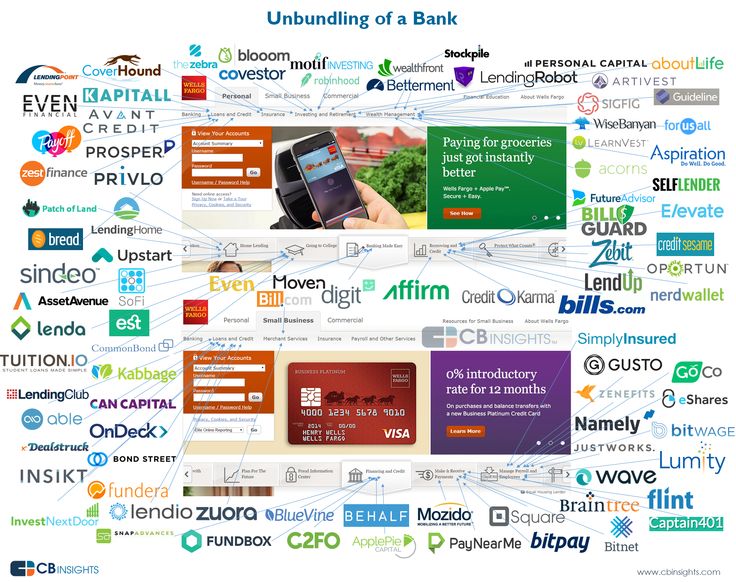By Ravi Viswanathan and Rick Yang
The size of an opportunity has a direct relationship with the potential for outsized returns. Again and again, we’ve seen that the companies with the largest magnitude of success are those that target massive markets, primed for innovation. Over the course of NEA’s 35+ year history, this market opportunity-to-success ratio has fueled disruption in industries from software to healthcare, to energy, to education, and beyond. Long story short: if the market’s big and the state of innovation is stagnant—we’re likely paying attention.
Financial Services is a multi-trillion dollar market. It’s also a market in the early innings of substantial transformation; evidenced by the explosion of next-gen fintech applications, products, and services. Another important catalyst here is the evolution of big banks. In many cases, their legacy systems are not agile enough to meet the demands of modern consumers—so while they continue to be the hub of financial lives, banks are no longer viewed as all-in-one financial service providers. What the banks do have is data—tons of it. This opens the door for third party applications that enable people to access information, manage finances, and connect data from a multitude of financial entities. All of these factors combine into a perfect storm for startups focused on transforming traditional banking and financial services.

Source: CBInsights
We’re not the only ones who have taken notice. In 2015, fintech funding for VC-backed companies hit an all-time high of $13.8bn across 653 deals, which was over two times the 2014 total of $6.7bn. Fintech funding overall (VC-backed and otherwise) has also nearly doubled, with 2015 dollars invested totaling $19.1bn (up from $10bn in 2014).
It’s been tremendously exciting to witness the recent traction within the fintech sector, as it’s an area we’ve had our eye on for years. NEA’s history in fintech dates back 20 years ago, when we first invested in Financial Engines, an early pioneer for online investment advice. Since then, we have steadily built a high quality portfolio of transformative companies including Braintree, Plaid, Forter,Robinhood, etc. The common thread for these investments is that they all represent the confluence of emerging trends and incorporate our expertise in these areas.

NEA Fintech Thesis
- The infrastructure layer. We see a transformation happening in fin tech similar to what happened in the broader enterprise software market in the 80’s and 90’s. That marked the beginning of a decades-long innovation cycle in software that continues today, with cloud and modern software architecture replacing the initial wave of on-premise software. Financial services has yet to have material innovation in purpose-built software that caters to this industry. We believe we are within the early stages of an entire infrastructure layer that is being built. This formed our initial thesis for our investment in Plaid, which is building a technology platform and integration layer (more on them to follow). The infrastructure layer is no longer commoditized; instead it is now enabling core product functionalities and driving superior user experience. Other examples where we have applied this thesis across the fintech stack:
- Payments: Braintree (acquired by PayPal in 2013) continues to ride the next-generation commerce and mobile wave. The company pioneered a developer friendly approach to the payments layer, realizing it was a critical piece of product and user experience in modern applications. This led to Braintree partnering with Uber, creating the ultimate product experience where the biggest feature was that the payment seamlessly integrated into the background.
- Security: Forter helps retailers prevent identity fraud, internet fraud and phone fraud. Transaction fraud has forced retailers to take one or both bad paths – the conservative approach of denying many potential customers, or putting customers through a horrible user experience to make it through checkout. Forter packaged a highly sophisticated back-end security system into seamless decision service resulting in a simple checkout flow for customers and higher revenue for retailers.
- The ultimate vertical market. We’ve been a big fan of vertical SaaS (or industry cloud) plays, which are massive markets (energy, healthcare, etc) where the incumbent solution may not even be software but rather pen/paper, excel, or labor. In one sense, financial services is the ultimate vertical market. While the business models here are not necessarily SaaS-based subscription revenues, fintech companies can have multiple models, including SaaS, as well as transaction-based and marketplace-based revenue models. These businesses pull the best from each model, resulting in a highly recurring revenue stream with additional upside.
- Big global plays. In past decades Silicon Valley owned the vast majority of the iconic, market changing companies. Fintech is a great evolution and re-think of this paradigm, as hubs have emerged in London, Israel, and New York. Our global footprint and mandate, coupled with our large capital base (often required to scale in fintech), enables us to be well positioned to build the next generation of market-leading companies.
- Developer friendly approaches. The rise of the software developer in the product development process has taken shape over the past five years. Developer-focused and API-based approaches have become a foundational element to modern software, and have enabled companies to build and release software much more quickly. The fintech market has benefited from these API-driven models, as evidenced by several companies including Braintree and Stripe for payments, and Plaid for infrastructure. This is especially important in a highly regulated space, where developers want to focus on their product and leave compliance and security to the experts. We believe this trend is here to stay and that we will see many more companies being built with these approaches in the fintech space.
- Consumer expectations have changed. The consumerization of enterprise has spread into the consumerization of everything, with users having the highest expectations for product and user experience. In particular, we have seen a consumer expectation in the fintech space in the following ways:
-
- Transparency and alignment. The financial services industry historically has been built on top of transaction fees that are confusing, and many times misaligned with consumers. It was only as recent as April 2016 where the conflict of interest rule was put in place, requiring advisors to put their customers’ best interests first! In addition, younger demographics have grown up through The Great Recession and Occupy Wall Street. This has resulted in mistrust of traditional financial institutions and a general dislike of debt. These consumers have higher trust in technology and are happy with fair exchanges in value.
- Context aware. With the abundance of data, consumers expect products and services to be context aware. Understanding each individual consumer and personalizing delivery of services is critical. This is especially important on mobile, where screen real estate is scarce and attention spans are short.
- Design driven product. Just as the barriers to create and release a product have come down, having a design driven product that delights users to differentiate amongst the pack has become paramount. This happens across the entire ecosystem – from the front end consumer interaction to the back-end developer interaction.
Of course, this sector is not without its challenges. Factors such as capital intensity (particularly within online lending), cost of capital arbitrages, and regulatory / compliance requirements can cause serious roadblocks to emerging companies across fintech. Team building can also be a struggle, as these startups often require deep domain expertise in a variety of areas ranging from financial compliance, global / regional regulations, underwriting, and relationships with the existing banking infrastructure. In addition, traditional banks have a reputation for being slow-moving due to their sheer size and ingrained practices. Still, they aren’t going away anytime soon, and as mentioned above, this creates many opportunities for startups in terms of partnering with banks and developing complementary products and services. We think that the most successful fintech startups will be those who work best with banks versus trying to displace them.
Enter Plaid. Plaid’s suite of APIs enables developers to create applications that interact with bank infrastructure. We were fortunate enough to meet Plaid in their early days—we participated in their Seed round in 2013, and led their Series A in 2015. The company sits at the core of our fintech investing thesis, enabling developers to deliver a superior and differentiated product that leverages existing banking data on top of a secure platform. They have assembled a diverse team of people passionate about transforming the financial infrastructure layer. From a clean API to simple and consistent user flows, design has been infused into all aspects of the platform.
Our enthusiasm for the team and the platform has only intensified. As far as application integration goes, we think Plaid is to fintech, as MuleSoft is to enterprise. Plaid has enabled the development of over 10,000 financial applications, primarily across payments, financial data, and analytics. They’ve also analyzed over 7bn transactions on behalf of clients, helping continuously improve data quality and fraud detection. This has put the company in a leadership position for any developer looking to build on top of financial data.
It’s on the heels of this incredible traction that they’ve announced their Series B financing, and we are again honored to partner with them as they aim to expand their presence within fintech, ecommerce, and risk/fraud markets. We’re also excited to welcome our friends from Goldman Sachs as the lead in this round of financing—it’s an added vote of confidence to have such a respected financial institution share enthusiasm for the company’s vision. The fintech infrastructure market has grown to $37bn globally, and we think Plaid has all of the makings to be the leading force in the space. Large opportunities lead to large successes, and we’re especially thrilled to be involved with this one.
-

Connect